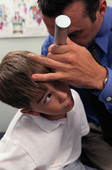
SATURDAY, Jan. 2 (HealthDay News) — Parents who’ve ever suspected their youngster had an ear infection might have been inclined to call the doctor, schedule a visit and expect an antibiotics prescription.
That’s been the ritual. But no more.
“Until eight or nine years ago, we’d treat each ear infection at diagnosis,” said Dr. David Tunkel, director of pediatric otolaryngology at Johns Hopkins School of Medicine and chairman of the pediatrics committee for the American Academy of Otolaryngology.
“The thought was, you would reduce the symptoms quicker,” Tunkel said. “Then it became clear that many children who weren’t treated with antibiotics actually did well without the initial treatment.”
As a result, Tunkel said, guidelines issued in 2004 by the American Academy of Pediatrics and the American Academy of Otolaryngology began to encourage what doctors call an “observation option.” That means that children 2 years and older who are otherwise healthy can be observed for a short period of time before being given antibiotics.
Ear infections are the most common illness among infants and young children, according to the U.S. National Institutes of Health, with an estimated three of every four kids having an ear infection before age 4. Usually infection occurs in the middle ear and is called otitis media. It’s called otitis media with effusion when fluid and mucus build up in the tubes of the middle ear.
Ear infections often clear up on their own. But another pediatric otolaryngologist, Dr. Richard Rosenfeld, stressed that “observation is different than no treatment.” Rosenfeld is chairman of otolaryngology at Long Island College Hospital and the State University of New York Downstate Medical Center and a consultant for the American Academy of Pediatrics on the ear infection guidelines.
When recommending observation before medication, he said, doctors might send parents home with a “safety net” prescription, one to have on hand in case the situation worsens. Parents should ask the doctor for specifics on the timeline for observation, which typically ranges from one to three days.
And while watching and waiting, the focus would be on pain relief.
But observation isn’t advised for all kids, even if they’re healthy and 2 years or older, Tunkel said. For instance, a child with a fever of 102 or more would typically be treated.
“We don’t want to withhold antibiotics from kids,” he said.
Rather, the guidelines are aimed to address concerns about resistance to antibiotics that can develop from overuse, he said.
Also, a study reported in the British journal BMJ in July found that ear infections come back more often in kids who’ve been treated with antibiotics. In the three years after being treated for an ear infection, 63 percent of the kids who were given the antibiotic amoxicillin had recurrent ear infections, compared with 43 percent of those not treated with an antibiotic.
“Parents are becoming used to the idea that antibiotics are not the first choice,” Tunkel said.
Rather, pain control and pain management might need to take center stage, at least initially. For pain, Rosenfeld suggests ibuprofen over acetaminophen because, he said, “it lasts longer.”
“If our goal is to get your child to sleep through the night, you are going to achieve that better with ibuprofen than acetaminophen,” he said.
“You have to be prepared to give lots of analgesics,” he said, with the exact amount something that must be discussed individually with the pediatrician.
Anesthetic ear drops, which usually require a prescription, can help but don’t produce prolonged relief, Rosenfeld said. And the practice of putting warm compresses on the outside of the ear can’t hurt, he said, but there’s no real proof that it works, either.
Someday, kids might be able to be vaccinated against ear infections. Scientists are working on developing such a vaccine and testing ways to deliver it, including rubbing it on the skin rather than injecting it, according to a presentation at the 2009 annual meeting of the American Society of Microbiology.
In the meantime, parents can take some simple measures to reduce the likelihood of their child developing an ear infection, Tunkel said. If parents smoke, stopping will reduce exposure to cigarette smoke, which is a risk factor for ear infections. And parents who choose a day-care setting with as few children as possible can, at least theoretically, reduce the pool of circulating germs, he said.
More information
The Nemours Foundation has more about ear infections.

